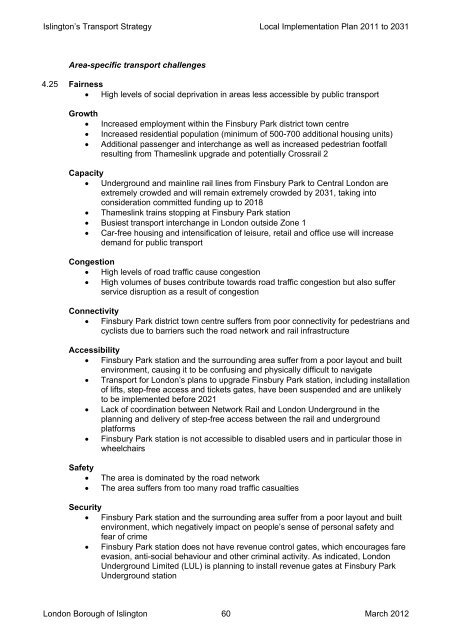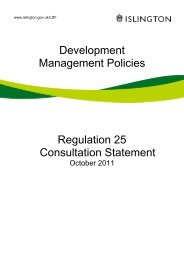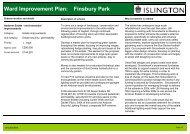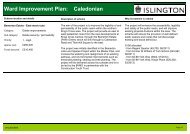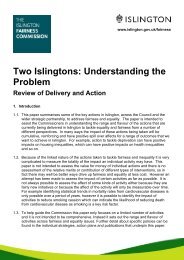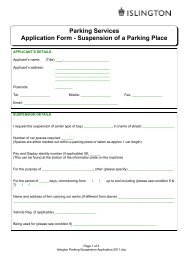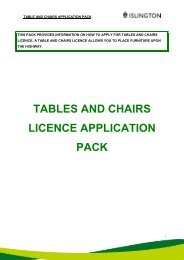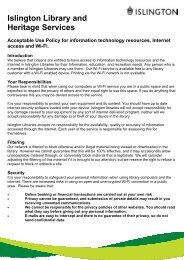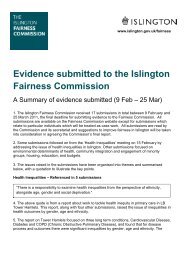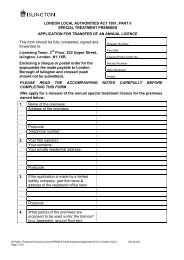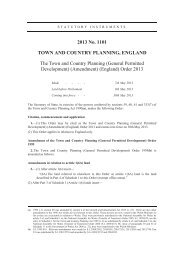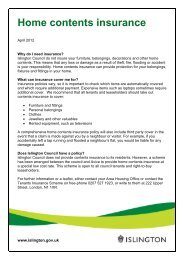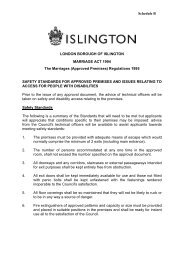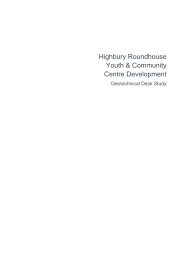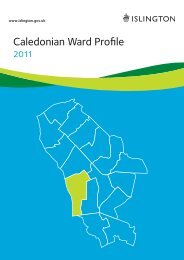Islington's Transport Strategy and Local ... - Islington Council
Islington's Transport Strategy and Local ... - Islington Council
Islington's Transport Strategy and Local ... - Islington Council
You also want an ePaper? Increase the reach of your titles
YUMPU automatically turns print PDFs into web optimized ePapers that Google loves.
<strong>Islington</strong>’s <strong>Transport</strong> <strong>Strategy</strong> <strong>Local</strong> Implementation Plan 2011 to 2031<br />
Area-specific transport challenges<br />
4.25 Fairness<br />
High levels of social deprivation in areas less accessible by public transport<br />
Growth<br />
Increased employment within the Finsbury Park district town centre<br />
Increased residential population (minimum of 500-700 additional housing units)<br />
Additional passenger <strong>and</strong> interchange as well as increased pedestrian footfall<br />
resulting from Thameslink upgrade <strong>and</strong> potentially Crossrail 2<br />
Capacity<br />
Underground <strong>and</strong> mainline rail lines from Finsbury Park to Central London are<br />
extremely crowded <strong>and</strong> will remain extremely crowded by 2031, taking into<br />
consideration committed funding up to 2018<br />
Thameslink trains stopping at Finsbury Park station<br />
Busiest transport interchange in London outside Zone 1<br />
Car-free housing <strong>and</strong> intensification of leisure, retail <strong>and</strong> office use will increase<br />
dem<strong>and</strong> for public transport<br />
Congestion<br />
High levels of road traffic cause congestion<br />
High volumes of buses contribute towards road traffic congestion but also suffer<br />
service disruption as a result of congestion<br />
Connectivity<br />
Finsbury Park district town centre suffers from poor connectivity for pedestrians <strong>and</strong><br />
cyclists due to barriers such the road network <strong>and</strong> rail infrastructure<br />
Accessibility<br />
Finsbury Park station <strong>and</strong> the surrounding area suffer from a poor layout <strong>and</strong> built<br />
environment, causing it to be confusing <strong>and</strong> physically difficult to navigate<br />
<strong>Transport</strong> for London’s plans to upgrade Finsbury Park station, including installation<br />
of lifts, step-free access <strong>and</strong> tickets gates, have been suspended <strong>and</strong> are unlikely<br />
to be implemented before 2021<br />
Lack of coordination between Network Rail <strong>and</strong> London Underground in the<br />
planning <strong>and</strong> delivery of step-free access between the rail <strong>and</strong> underground<br />
platforms<br />
Finsbury Park station is not accessible to disabled users <strong>and</strong> in particular those in<br />
wheelchairs<br />
Safety<br />
<br />
<br />
The area is dominated by the road network<br />
The area suffers from too many road traffic casualties<br />
Security<br />
Finsbury Park station <strong>and</strong> the surrounding area suffer from a poor layout <strong>and</strong> built<br />
environment, which negatively impact on people’s sense of personal safety <strong>and</strong><br />
fear of crime<br />
Finsbury Park station does not have revenue control gates, which encourages fare<br />
evasion, anti-social behaviour <strong>and</strong> other criminal activity. As indicated, London<br />
Underground Limited (LUL) is planning to install revenue gates at Finsbury Park<br />
Underground station<br />
London Borough of <strong>Islington</strong> 60 March 2012


